Scoliosis
-
Schedule an appointment with Orthopedics and Sports Medicine
- For appointments, call 206-987-2109.
- How to schedule
- Need a second opinion? Call 206-987-2109.
If this is a medical emergency, call 911.
-
Find a doctor
-
Locations
-
Refer a patient
- View our hip dysplasia algorithm to help triage and answer questions about when to refer a patient for hip dysplasia.
- Due to the high volume of infant hip dysplasia referrals, we ask that patients with normal (stable) hip exams be screened following the AAP guidelines
- Urgent consultations (providers only): call 206-987-7777or, toll-free, 877-985-4637.
- If you are a provider, fax a New Appointment Request Form (NARF) (PDF) (DOC) to 206-985-3121 or 866-985-3121 (toll-free).
- View our complete Orthopedics Referral Information.
What is scoliosis?
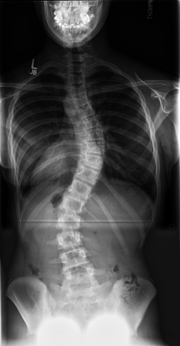 Scoliosis can affect the position of your child’s rib cage as well as their spine.
Scoliosis can affect the position of your child’s rib cage as well as their spine.Scoliosis is a sideways curve in the spine. On an X-ray, most children’s spines look straight. The spines of children with scoliosis curve to the side, like the shape of the letter S or C.
Many children have slight side-to-side curves in their spines. They usually do not need treatment. In children with scoliosis, the bones of the spine (vertebrae) have greater than 10 degrees of curve.
-
Types of scoliosis
There are many types of scoliosis. Finding out what type your child may have is important because different types of scoliosis progress in different ways and need different treatments.
- Idiopathic scoliosis: Idiopathic means we do not know the definite cause of the problem. There is no known problem with the bones, nerves or muscles in the spine causing the curve. This is the most common form of scoliosis in adolescents. It is less common in infants and young children. Based on your child’s age, doctors might call this infantile, juvenile or adolescent idiopathic scoliosis.
- Congenital scoliosis: Some vertebrae are shaped incorrectly from birth. As your child grows, these vertebrae grow incorrectly, causing scoliosis to develop.
- Neuromuscular scoliosis: Problems with the muscles or nervous system, such as cerebral palsy, muscular dystrophy or a spinal cord cyst (syrinx), cause the spine to curve.
- Reactive or functional scoliosis: Sometimes children who have back pain will bend their backs to the side in response to the pain. The child’s curve is flexible. It will go away if the problem that causes the child to bend goes away.
- Syndromic scoliosis: Some children with musculoskeletal syndromes like Marfan syndrome, neurofibromatosis or Prader-Willi syndrome also have scoliosis.
- Traumatic scoliosis: A fracture of the spine or a spinal cord injury causes this type of scoliosis.
- Degenerative scoliosis: The curve forms because discs and joints in the spine are worn down. Usually this type affects older adults.
-
How common is scoliosis?
Between 1 and 3 of every 100 children have idiopathic scoliosis (more than 10 degrees of tilt on an X-ray, with no known cause). But only about 2 of every 1,000 children ever develop a curve large enough to need treatment.
Equal numbers of boys and girls have the smaller curves that need no treatment. Girls are 7 times as likely as boys to have the larger curves in their spines.
Scoliosis at Seattle Children’s
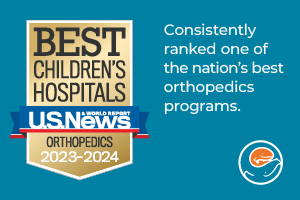 The Spine Program at Seattle Children’s brings together a team of specialists to treat every type of scoliosis in babies, children, teens and young adults using nonsurgical and surgical methods. We have treated thousands of children with scoliosis, and our team is known nationally for treating all kinds of spinal deformities in children.
The Spine Program at Seattle Children’s brings together a team of specialists to treat every type of scoliosis in babies, children, teens and young adults using nonsurgical and surgical methods. We have treated thousands of children with scoliosis, and our team is known nationally for treating all kinds of spinal deformities in children.
-
The experts you need are here
- The Spine Program team includes doctors, surgeons, physician assistants (PAs) and nurse practitioners (NPs) from Orthopedics and Sports Medicine. For more severe curves that are more difficult to correct and that affect the spinal cord and lungs, our orthopedic specialists often work with experts from Neurosciences and Pulmonary and Sleep Medicine.
- We offer your child the support of an entire medical center. Based on your child’s needs, we involve specialists from other areas of Seattle Children’s, such as Adolescent Medicine, Rehabilitation Medicine and Pain Medicine.
- If your child needs surgery, our pediatric orthopedic surgeons have expanded fellowship training in spine problems.
- Nonsurgical treatment commonly means a back brace to keep a spinal curve from getting worse in a child who is still growing. Our onsite orthotists, who build and fit braces, see your child at the same visit with your child’s doctor, PA or NP to coordinate your child’s care.
-
Care from birth through young adulthood
- Babies, children and teens are still developing. When we evaluate your child’s scoliosis, design their treatment and provide their care, we carefully consider how growth may affect your child’s spinal curve over time – and how their spinal curve may affect the rest of their development and health.
- Our experts are skilled in treating the youngest patients, including babies with infantile scoliosis and young children with early-onset scoliosis, through young adults.
- If your child needs imaging that uses radiation, we use the lowest amount possible to produce the best image. We also have a low-dose radiation X-ray machine, called the EOS, for safe full-body images, and the largest group of board-certified pediatric radiologists in the Northwest.
-
Our approach to surgery improves quality of life
- When growing rods were developed in the early 2000s, Seattle Children’s was among the first to offer them to address spinal curvature in children. The rods allow your child to continue growing through the early years of life.
- Seattle Children’s offers the MAGnetic Expansion Control (MAGEC) system, which reduces the number of surgeries your child may need for severe scoliosis. Instead of surgery every 6 months to lengthen their growing rods, your child comes for an office visit. The surgeon lengthens the rods using a remote control.
- Before recommending any surgery, we look at your child as a whole person and take into account many factors, including the degree of their spinal curve, the effects on their health, their remaining growth and what results you can expect from different procedures.
- Our surgical spinal cord monitoring team leads the country in developing new techniques for making back surgery safer. We have developed recent advances in spinal cord monitoring and treatment of scoliosis in very young children. Neuromonitoring helps us prevent a spinal cord injury during surgery.
- We have the technology and expertise to place hardware, such as rods and screws, in your child’s spine using X-rays during surgery or CT (computed tomography)–guided surgery.
-
Support for your whole family
- Your child’s team not only plans and provides care for your child, but also makes sure you and your child understand your child’s condition and treatment options.
- Coordination is easier for you because your Spine Program team includes experts from Orthopedics, Neurosciences and Pulmonary Medicine, who work closely with each other and with other specialized programs and clinics your child may need, like the Neuromuscular Clinic for muscular dystrophy or the Ortho Rehab Clinic for CP.
- Seattle Children’s supports your family with a range of resources, such as Child Life specialists, the Family Resource Center and Guest Services.
- Our video series helps you know what to expect before, during and after surgery for scoliosis.
Scoliosis: Your pre-op appointment (video 2:50)
-
Research and advances to improve care
- Seattle Children’s has one of the largest growing-rod programs in the country, and we are a leader in studying the impact and effectiveness of growing rods.
- We were involved in developing technology called vertical expandable prosthetic titanium rib (VEPTR). VEPTR is a variation of growing rods that we use to treat spine conditions in very young children who have fused ribs, congenital scoliosis and severe chest wall deformities.
- Severe early-onset scoliosis is rare, so no single hospital treats enough patients to study the condition effectively on its own. As part of the Children’s Spine Study Group, Seattle Children’s teams with other top-tier children’s hospitals around the country to find better ways to meet the challenges faced by children with severe early-onset scoliosis.
- Our surgeons have led research to reduce your child’s exposure to radiation from imaging tests, like X-rays and CT scans, before and during surgery.
Symptoms of Scoliosis
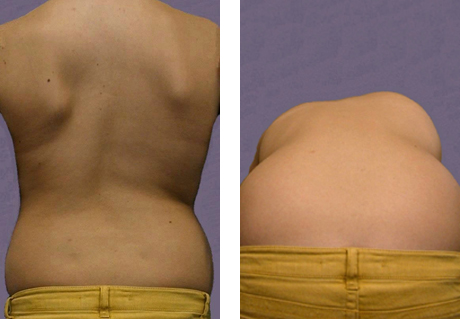 Left: Adolescent with scoliosis. Right: Appearance when bending forward.
Left: Adolescent with scoliosis. Right: Appearance when bending forward.
Until scoliosis is over 30 degrees, it can be hard to detect when your child is standing. Because of the rotation of the spine and rib cage, curves are easier to see when your child bends forward.
-
Other signs of scoliosis
- One shoulder is higher than the other. (A slight difference in shoulder height is common in people who do not have scoliosis.)
- Your child’s shoulder blade sticks out on one side of their back when they are standing up.
- Your child’s waist looks higher on one side. This is called waist asymmetry.
- Your child’s chest wall looks larger on one side than the other. Older girls may notice that one breast looks larger than the other.
- In some children, the entire trunk may shift to the right or left. They may look like they are leaning to one side.
Many children have mild back pain. Scoliosis does not usually cause this pain, but some things that cause back pain may cause scoliosis.
Treating Scoliosis
Seattle Children’s Spine Program offers the most current treatments for children with scoliosis. These can include surgical and nonsurgical options to correct a curve or keep a curve from getting worse.
We are concerned about small curves in children because they can progress quickly during growth. When children have a larger curve and still have a lot of growth left, there is a good chance that the curve will get much bigger. If the curve is small and there is not much growth left, there’s much less chance of the curve getting bigger.
The goal of treatment for your child is to reach the end of their growth with a curve of less than 50 degrees. Curves less than 50 degrees at the end of growth do not usually require surgery or keep getting bigger. The 3 most common treatment options that our scoliosis specialists recommend are observation, bracing and surgery.
Nonsurgical Treatments for Scoliosis
-
Observation
Observation usually involves an exam and X-ray of the spine every 6 months. If your child is growing rapidly or the curve is getting worse, they may need an exam and X-ray more often. Scoliosis is more likely to progress during periods of rapid growth, like just before puberty.
Keeping a record of your child’s height can help determine their rate of growth. Once your child has stopped growing, we will monitor them less often.
-
Bracing
A brace is a common treatment for children with curves between 25 and 45 degrees who are still growing. Bracing is not used for children who have finished growing.
The brace is used to prevent the curve from getting worse. It will not make the curve go away.
If your child begins treatment with a brace, they may wear it until they finish growing or the curve gets so large that they need surgery.
With this therapy, fitting the brace correctly is important. We have extensive experience in making braces to fit children of all sizes and ages. Read about braces and our other orthotics and prosthetics services.
-
Diet, supplements and exercise
Children who have scoliosis may have a higher chance of developing weak bones (osteoporosis) later in life. Depending on your child’s needs, we may recommend diet changes or supplements to make sure they get enough calcium and vitamin D. Check with your healthcare provider first before giving any vitamin or supplement to your child.
It’s also important for your child to get regular weight-bearing exercise, like walking or running. Regular play and exercise are important for your child’s health and for preventing back pain. Physical education classes are good for children with scoliosis.
-
Schroth physical therapy and other options
The most common type of physical therapy used for scoliosis is called the Schroth method. Seattle Children’s has physical therapists trained in Schroth physical therapy, which may be appropriate for some children with small curves.
With this method, your child learns and practices exercises during visits with a physical therapist and uses these exercises every day at home. Read more about Schroth physical therapy (PDF).
Other forms of therapy, such as chiropractic, electrical stimulation, massage or yoga, do not hurt the spine and may be helpful for back pain. But it’s not clear that they keep scoliosis from getting worse.
Surgery for Scoliosis
Children with spinal curves greater than 50 degrees may benefit from surgery. In rare cases, when a child has a lot of growth remaining, we may recommend surgery sooner (40 to 50 degrees).
The goal of surgery is to prevent the scoliosis from getting worse and to correct the deformity as much as possible.
Our surgical team uses different types of operations to correct the curve and stabilize the spine.
-
Spinal fusion
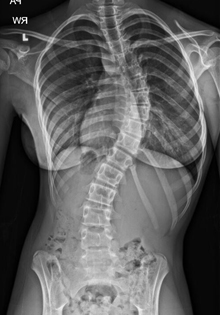 Before instrumentation.
Before instrumentation.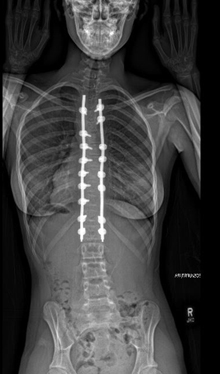 After instrumentation.
After instrumentation.The most common operation for scoliosis is spinal fusion. This surgery straightens your child’s spine by releasing some of the ligaments and joints around the spinal cord. We then attach metal rods and screws to the bones in the back.
In a spinal fusion operation:
- The doctor makes a cut (incision) to reach your child’s spine. The doctor reaches the spine either from the back or from the side.
- The doctor puts screws in the bones of the spine, removes the joints between the bones and attaches the rod to the screws. (Devices like rods and screws are sometimes called spinal instrumentation.)
- Your child’s spine is repositioned so that it is straighter.
- Then the surgeon tightens the screws to make sure they are firmly attached to the rod.
- Finally, the surgeon places a bone graft along the spine to help the bones of the spine grow together to form one large bone. The screws and rods are almost always permanent, but in rare cases may be removed.
-
Growing rods, MAGEC and VEPTR
This operation may help very young children whose spines are still growing and who are not helped by treatment with a back brace.
The operation uses spine-supporting metal rods that can be lengthened as your child grows. As in spinal fusion, the doctor attaches a rod to the bones in your child’s spine. Unlike spinal fusion, the doctor does not remove the joints between the bones and does not fuse the spine.
There are 2 ways to lengthen your child’s growing rod:
- With conventional growing rods, your child needs surgery about every 6 to 9 months to lengthen the rod.
- With the MAGEC system, a surgeon lengthens the rod every few months at a clinic visit by holding a remote control against your child’s back. Each click of the remote activates a magnet in the growing rod that turns a screw and extends the rod a third of a millimeter – about the width of a grain of sand.
For very young children who have fused ribs, congenital scoliosis and severe chest wall deformities, we use a variation of growing rods called VEPTR. It can attach to ribs or parts of the spine or pelvis.
-
Scoliosis: Your pre-op appointment (video 2:50)
Dr. Wally Krengel explains what to expect during your scoliosis surgery pre-op appointment at Seattle Children’s. This is 1 of a 5-part series on scoliosis surgery. Watch the other videos in the series.
-
Scoliosis: Potential surgery risks (video: 7:57)
-
Scoliosis: Returning to activities after surgery (video: 3:53)
Research and Clinical Trials
Our research into severe early-onset scoliosis focuses on how scoliosis affects lung function. Dr. Gregory Redding is leading a multisite study to help clarify when growing rods provide the best possible treatment for scoliosis patients with lung disease. We’re also part of the Children’s Spine Study Group, which brings together the nation’s top children’s hospitals to improve care for patients with severe early-onset scoliosis.
Another important area of research for us is how to limit the radiation your child may be exposed to from imaging scans before or during surgery.
Learn about research studies and clinical trials at Seattle Children’s.
Contact Us
Contact Orthopedics and Sports Medicine at 206-987-2109 for an appointment, a second opinion or more information.
Providers, see how to refer a patient.
-
Schedule an appointment with Orthopedics and Sports Medicine
- For appointments, call 206-987-2109.
- How to schedule
- Need a second opinion? Call 206-987-2109.
If this is a medical emergency, call 911.
-
Find a doctor
-
Locations
-
Refer a patient
- View our hip dysplasia algorithm to help triage and answer questions about when to refer a patient for hip dysplasia.
- Due to the high volume of infant hip dysplasia referrals, we ask that patients with normal (stable) hip exams be screened following the AAP guidelines
- Urgent consultations (providers only): call 206-987-7777or, toll-free, 877-985-4637.
- If you are a provider, fax a New Appointment Request Form (NARF) (PDF) (DOC) to 206-985-3121 or 866-985-3121 (toll-free).
- View our complete Orthopedics Referral Information.